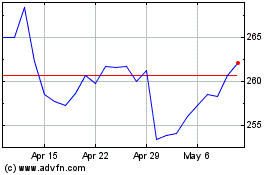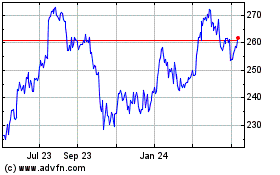By Akane Otani
Wall Street expects U.S. companies to report gains in
fourth-quarter earnings in coming weeks, extending a recent
recovery and providing fresh fuel to major U.S. stock indexes after
a run of records in late 2016.
On Tuesday, the first trading day of 2017, shares of financial
companies surged, in part on optimism for their profitability this
year, helping the Dow Jones Industrial Average jump 119.16 points
to 19881.76, snapping a three-session losing streak. The broader
S&P 500 added 0.85%.
Earnings at S&P 500 companies will rise 3.2% from a year
earlier in the fourth quarter, according to analysts polled by
FactSet. That builds on a 3.1% gain in the third quarter, which
marked the first year-over-year rise in corporate earnings since
the first quarter of 2015 and could point to a more lasting
breakout, analysts said.
The fourth-quarter earnings season kicks off in earnest
Thursday, with Walgreens Boots Alliance, Monsanto Co. and
Constellation Brands expected to report results that day. Banks,
including J.P. Morgan Chase & Co., are slated to report results
Jan. 13. By the end of January, 149 companies are expected to have
reported results, according to the WSJ Market Data Group.
Donald Trump's election revved up investors' hopes for
business-friendly policies and the gains since Nov. 8 in major
stock indexes have largely been attributed to the potential for tax
cuts, looser regulation and fiscal spending under the new
administration.
Investors say another strong quarter of earnings reports could
help bridge the gap between now and later this year, when many
expect Congress to begin enacting policies that aim to speed up
economic growth and would likely bolster corporate profits.
Corporate profits are among the strongest determinants of market
performance, investors and analysts say.
"It's earnings growth that drives stocks over the long term,"
said Tom Cassidy, chief investment officer at Univest Corp. of
Pennsylvania's Wealth Management Division. While "we won't know if
any of these policies will actually be implemented" until later in
the year, a rise in earnings typically results in additional stock
gains, Mr. Cassidy said.
Analysts expect earnings at S&P 500 companies to grow by 11%
from a year earlier in the first quarter, 11% in the second
quarter, 9.1% in the third quarter and 14% in the fourth, according
to data from FactSet.
It is a long-awaited improvement. An end to the longest earnings
slump since the financial crisis comes against a backdrop of
improving economic data.
Valuations have risen above their long-term average, prompting
many analysts to warn that stock gains could be vulnerable without
an upswing in corporate profits.
U.S. gross domestic product, a broad measure of the goods and
services produced across the economy, posted its strongest
quarterly pace of growth in two years in the third quarter,
according to data released by the Commerce Department in
December.
On Tuesday, the Institute for Supply Management's manufacturing
index rose in December to its highest levels in two years, the
latest sign of momentum in the U.S. factory sector. Separately,
Markit's manufacturing index rose to a 21-month-high last
month.
Some analysts point to an improved outlook for financial
companies, driven in part by expectations that Trump administration
policies will boost growth and inflation, resulting in a steeper
"yield curve" that benefits banking firms' profits.
The S&P 500 financials sector was up 20% in 2016 and was
responsible for nearly half of the total earnings growth for the
S&P 500 in the third quarter, according to FactSet data.
Financials posted 8% year-over-year earnings growth, according
to FactSet. J.P. Morgan Chase, Citigroup Inc., Wells Fargo &
Co., Bank of America Corp., Goldman Sachs Group Inc. and Morgan
Stanley all beat analysts' estimates on an earnings-per-share
basis.
Several lenders, including J.P. Morgan, the largest U.S. bank by
assets, reported a rebound in their trading businesses. While low
interest rates have for years cut into banks' net interest margins
-- a key measure of lending profitability -- events like the U.K.'s
surprise vote to leave the European Union or uncertainty around the
Federal Reserve's next steps on interest rates have helped boost
trading revenue, some of the banks said.
Many of the banks expect trading gains to continue. Executives
at Citigroup, Bank of America and J.P. Morgan said at a banking
conference in early December that they expect key fourth-quarter
trading metrics to grow by double-digit percentages from a year
earlier.
Utilities are expected to perform well, too. Analysts polled by
FactSet see earnings for the S&P 500 utilities sector growing
by 20% for the fourth quarter from a year earlier. Technology,
consumer staples and health care are expected to report earnings
growth in the single-digit percentages for the fourth quarter.
But risks remain.
Industrials -- which have helped lead the recent stock-market
rally with a 7% gain in the S&P 500 since Election Day -- are
expected to report an earnings decline of more than 8% in the
fourth quarter from a year earlier, according to analysts polled by
FactSet.
Caterpillar is projected to be among the biggest drags on the
sector's earnings in the fourth quarter. Shares of the maker of
construction and mining equipment -- whose results are closely
watched as a barometer for global manufacturing activity -- gained
36% in 2016.
But for the fourth quarter, the company is expected to report
earnings of 66 cents a share, down from expectations of $1.02 a
share at the start of the quarter, according to FactSet
estimates.
The company said in October that it could report a loss for the
year and predicted another tough year for 2017 amid weak
demand.
A strengthening U.S. dollar could also hamper the earnings of
multinational companies. While a stronger dollar increases U.S.
buyers' purchasing power abroad, it also makes U.S. exports more
expensive to foreign buyers, putting pressure on the bottom lines
of companies that receive a significant chunk of their revenue from
abroad. Roughly 31% of S&P 500 revenue come from outside the
U.S., according to FactSet estimates. The dollar has rallied since
Election Day on prospects of a higher-growth, higher-rate
environment, which makes it more attractive to yield-seeking
investors. The WSJ Dollar Index, which measures the dollar against
a basket of 16 other currencies, gained about 3% in 2016.
The prolonged S&P 500 earnings slump has also helped make
stocks more expensive than their historical averages. The S&P
500 was trading at around 21 times its past 12 months of earnings
last week, according to FactSet. Its 10-year price/earnings average
is 16.
"People are very inclined to ignore P/E values going up," said
Bret Chesney, senior portfolio manager at Alpine Global, who added
that he thinks stocks are too expensive relative to how companies
have performed over the past several quarters. "I wouldn't be too
gung-ho to invest at these levels."
Still, many analysts believe there is reason to be optimistic
about the coming year.
"There's some meat to the rally," said Karyn Cavanaugh, senior
market strategist at Voya investment Management. "I think 2017 is
shaping up to be a good year."
Write to Akane Otani at akane.otani@wsj.com
(END) Dow Jones Newswires
January 03, 2017 19:33 ET (00:33 GMT)
Copyright (c) 2017 Dow Jones & Company, Inc.
Constellation Brands (NYSE:STZ)
Historical Stock Chart
From Mar 2024 to Apr 2024

Constellation Brands (NYSE:STZ)
Historical Stock Chart
From Apr 2023 to Apr 2024
